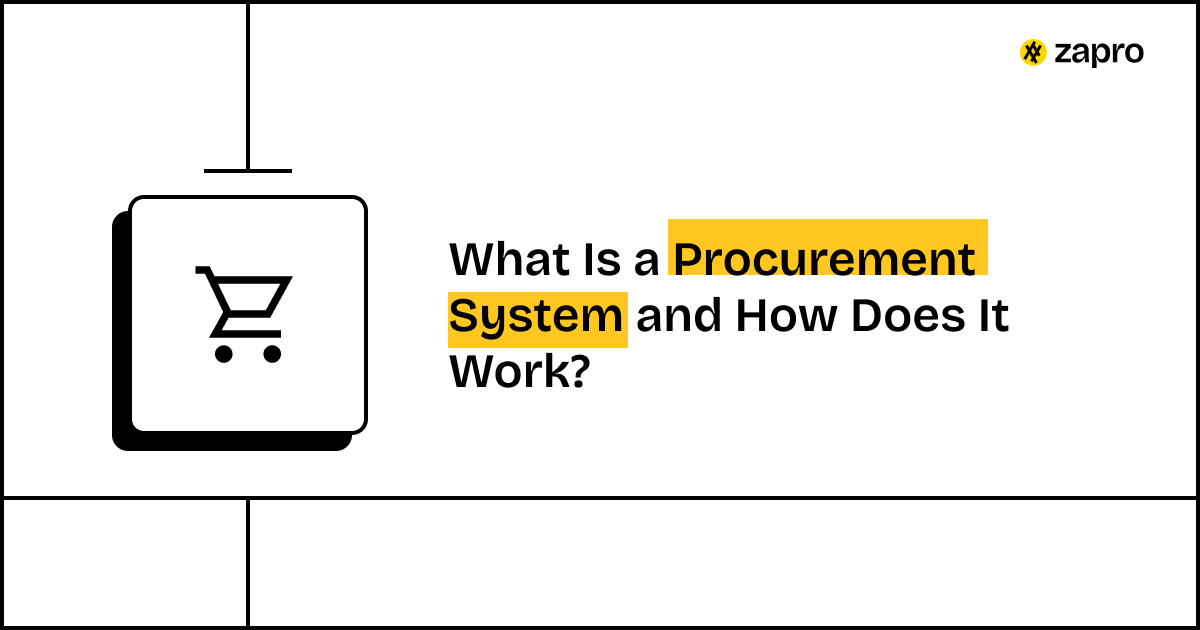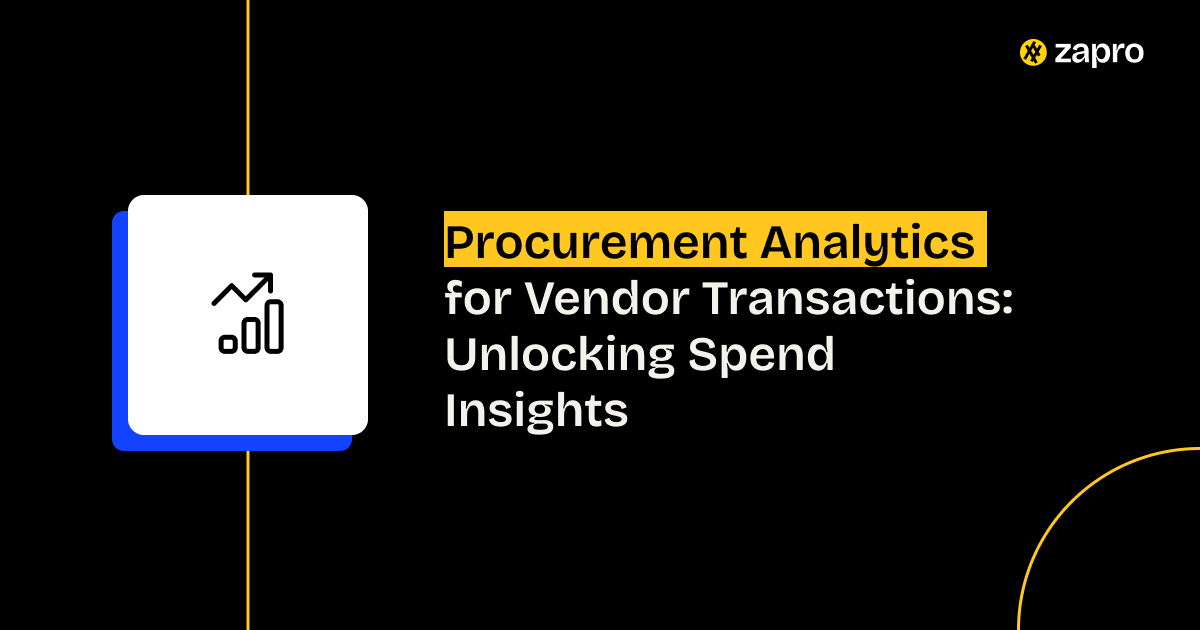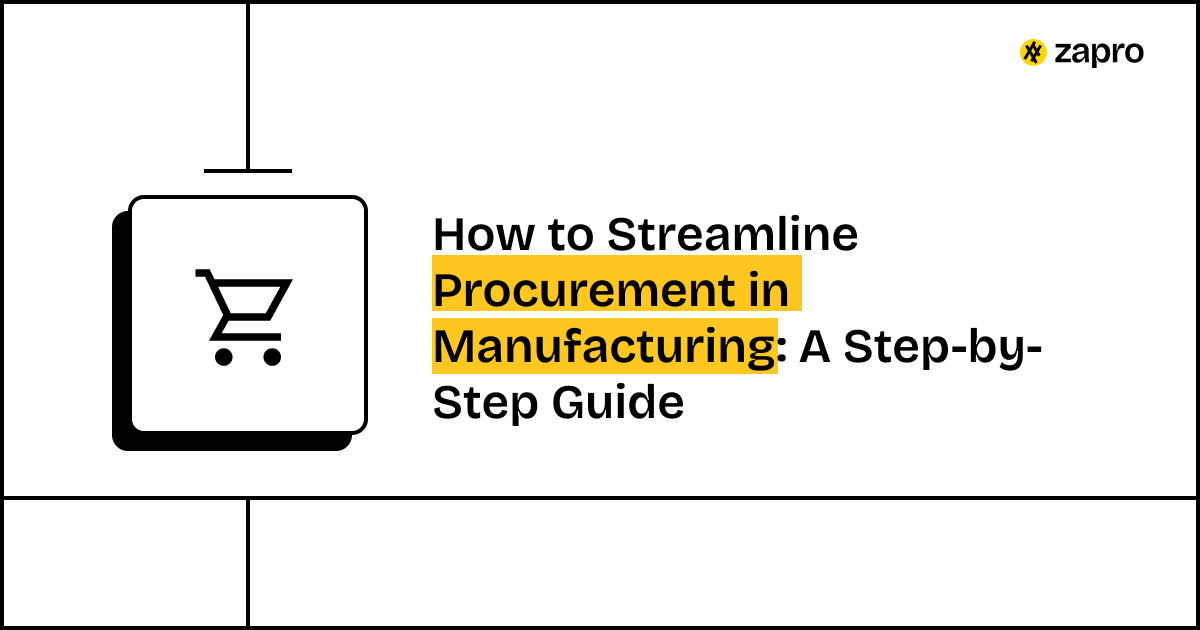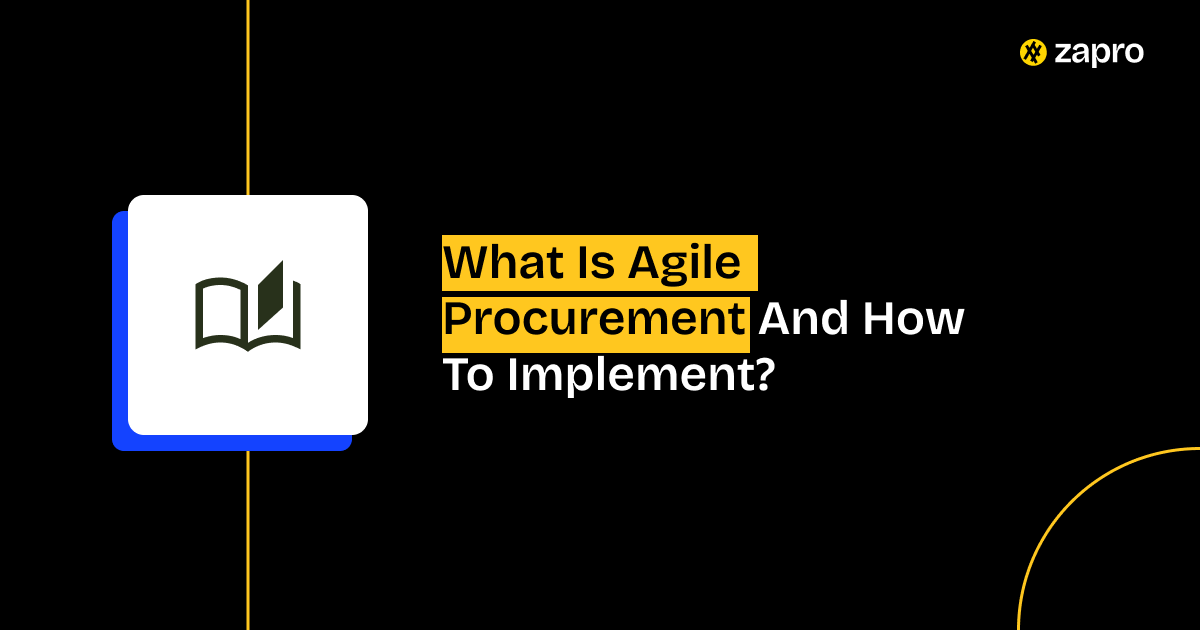Do you feel like your business is bleeding money through inefficient buying?
You’re not alone.
Research indicates that organizations experience 20% lower procurement efficiency when they maintain traditional procurement systems and manual methods. The money lost through outdated manual methods represents a significant amount which organizations could redirect toward business expansion or product development or profit enhancement.
A contemporary procurement system functions as the solution to address these issues. If you are wondering as to “what is a procurement system?” and “what its operational impact is on your business operations?” The following guide provides the basic definition of procurement in business and system types and demonstrates why automated procurement systems are essential for modern business success.
What Is A Procurement System?
A procurement system functions as an organized framework which enables businesses to acquire necessary operational materials and services. The entire process together with its tools and personnel functions as a system to obtain raw materials and office supplies. The system exists to deliver required items at optimal prices and quality levels during the needed time period.
The traditional procurement process involved disorganized paper-based operations. The process of requesting something required form completion followed by multiple signatures and inter-office mail delivery before the request became lost in transit. The traditional method of procurement operated at a slow pace while producing numerous mistakes and providing minimal insight into organizational spending.
The current procurement system uses technological advancements to establish an efficient and unbroken operational process. The procurement management system unifies all purchasing operations into one platform which provides clear visibility and control over buying activities. The main elements of a purchasing system include:
- Sourcing: Finding and evaluating suppliers.
- Purchasing: Creating and tracking orders.
- Payment: Reconciling invoices and making payments.
The purchasing system operates as the central operational system which maintains both strategic and smooth execution of all business activities.
What Are The 3 Types of Procurement?
The procurement process consists of separate categories which organize purchases according to their nature. The identification of these categories enables organizations to create specialized processes and select appropriate procurement system software features.
1. Direct Procurement
The process of direct procurement involves acquiring raw materials and components and finished goods which directly enter into the production of your final product or service. Your business requires these essential items to generate its products for sale.
- Examples: The car manufacturer buys steel and the bakery purchases flour and sugar and yeast as part of their direct procurement activities. The bakery requires flour and sugar and yeast as its main procurement items.
- Typical Business Spend: The total spend of manufacturing companies reaches 50-70% from direct procurement which directly affects both product costs and quality standards.
2. Indirect Procurement
The business operations require all necessary goods and services which do not transform into end products. These are the “behind-the-scenes” purchases.
- Examples: The procurement of office supplies and marketing services and IT equipment and cleaning services and utilities and employee travel expenses falls under this category.
- Typical Business Spend: The total spend from indirect procurement remains lower than direct procurement but reaches substantial levels between 15-30% of total company expenses thus offering significant opportunities for cost reduction through improved management practices.
3. Services Procurement
The procurement process for specialized services stands as a distinct category under indirect procurement which focuses on acquiring non-physical service products.
- Examples: The procurement of consultants and legal services and marketing agencies and temporary staff and maintenance and repair services falls under this category.
- Typical Business Spend: The amount of business spend on this category fluctuates based on industry requirements and project demands yet it continues to grow as a significant budget item that needs thorough contract oversight and performance evaluation.
The definition of procurement in business encompasses all these types, and a good procurement system should be able to handle the unique demands of each.

By 2027, 50% of organizations will support supplier contract negotiations through the use of AI‑enabled contract risk analysis and editing tools.
– Gartner
What Are The 4 Types Of Procurement Systems?
Different procurement systems exist at various levels of sophistication. The procurement industry uses basic traditional methods alongside state-of-the-art integrated platforms for its operations. Your business needs to understand its current position through this knowledge to determine its future development path.
Manual Systems
- What it is: The traditional procurement method depends on paper documents and spreadsheets and phone calls and email communication. The approval process requires physical signatures while tracking requires manual entry of updates.
- Pros: The initial investment for this system remains minimal because it only requires basic writing materials and paper supplies.
- Cons: The system operates at a slow pace while producing many errors and lacks real-time monitoring capabilities and becomes challenging to track and results in uncontrolled spending and operates with low efficiency.
- Best for: The system works best for businesses that have minimal purchasing needs and operate as small entities.
Automated Procurement
(Basic Digitization)
- What it is: The systems implement digital solutions for particular procurement activities but they do not transform all processes into digital format. The system enables purchase order generation through software but it still uses email for approval processes and maintains separate systems for supplier interactions.
- Pros: The system decreases paper usage while delivering enhanced speed and accuracy performance than manual methods.
- Cons: The system maintains separate information silos while lacking strong integration capabilities and requiring users to perform manual data transfers between different systems.
- Best for: The system works best for businesses with 10 to 100 employees who want to start their digital procurement journey.
Cloud-Based Procurement Systems
- What it is: An e-procurement system or electronic procurement system hosted on the internet enables users to access it from any location with internet access. The system operates without requiring internal server infrastructure and IT support for maintenance.
- Pros: The system provides easy access to users while offering flexible growth capabilities and automatic software updates and minimal IT support needs and user-friendly interfaces that support remote work operations.
- Cons: The system depends on internet connectivity for operation but users must address security risks that reputable providers address through strong protection measures.
- Best for: The system provides excellent benefits to businesses of all sizes and distributed teams which need flexible solutions for expansion.
Integrated Systems
- What it is: The system operates as an advanced cloud-based procurement system which links directly to Enterprise Resource Planning (ERP) systems (SAP and NetSuite) and accounting software and inventory management tools to deliver complete “source-to-pay” (S2P) or “procure-to-pay” (P2P) solutions.
- Pros: The system provides complete end-to-end visibility and automated departmental data exchange which removes information silos and enables better strategic choices and financial optimization.
- Cons: The system demands extensive planning for integration because it comes with high costs and complex implementation procedures.
- Best for: The system serves businesses with 50 to 500 employees who need complete financial management and operational excellence throughout their organization.
What Features Should A Procurement System Have?
Your search for a procurement management system should focus on features which solve your specific problems while enhancing operational efficiency. Here are the essentials:
Essential Features:
Purchase Requisition Management:
The system enables employees to submit purchase requisitions through simple request forms which include automated routing and guided input fields.
Approval Workflows and Routing:
The system enables organizations to create customizable multi-stage approval processes which direct requests to appropriate managers through automated routes based on spending thresholds and departmental affiliations and project designations.
Vendor/Supplier Management:
The system maintains a single database which contains supplier details and their contracts along with performance records and communication records. This is crucial for supplier management for small companies.
Automate purchase requisitions and approvals

Purchase Order Creation and Tracking:
The system generates professional purchase orders automatically from approved requisitions while providing real-time tracking of order status and delivery and receipt information.
Feature Importance & Complexity:
The importance and complexity of features differ based on business size because each organization requires different essential features. The core operations of purchase order automation and approval workflow management serve as essential components for businesses of all sizes. Large organizations require complete system integration and sophisticated analytical tools to operate effectively. The implementation process for basic PO automation systems remains simple but complex ERP integration needs extensive planning.
What Are The Benefits Of A Procurement System?
The implementation of the modern procurement system requires more than digital transformation because it enables organizations to achieve specific measurable advantages that enhance their financial performance..
1. Cost Savings:
The implementation of procurement automation leads to cost reductions which amount to 5-15% of total procurement expenses through the elimination of unauthorized spending and the use of supplier discounts and optimized purchasing quantities.
2. Process Efficiency:
The automation of manual operations through the system enables businesses to complete their requisition-to-payment cycle at speeds ranging from 60% to 80% faster. Your team can redirect their efforts toward strategic work because of this time-saving capability.
3. Compliance Improvement:
The implementation of an automated procurement system helps organizations maintain 95% policy compliance through automated enforcement of internal rules and regulatory requirements which minimizes audit risks.
4. Spend Visibility and Control:
The centralized dashboard provides instant access to complete spending data which enables you to track all financial activities in real time. The system enables you to discover hidden costs while making decisions based on accurate financial information.
ROI Statistics: Organizations that deploy advanced e procurement systems achieve their return on investment through cost savings and operational efficiency improvements which generate financial benefits within a short period of months rather than years. The optimization of supplier contracts and process automation enables mid-sized businesses to achieve annual savings of hundreds of thousands of dollars.
What Features Should You Look For In A Procurement System?
Your business needs determine the selection of appropriate procurement system software which demands thorough evaluation. The selection process demands individual assessment for each business requirement.
Business Size and Complexity Needs:
The requirements of small startups differ from multinational corporations when selecting procurement software. The system needs to maintain its ability to expand with your business growth. Does your organization require procurement automation for SMBs or enterprise-level solutions?
Industry-Specific Requirements:
Your industry requires specific compliance standards which the system must fulfill (e.g. healthcare and manufacturing). The system needs to handle all necessary requirements of your industry.
Integration with Existing Systems:
The system needs to integrate seamlessly with all your current business applications. The system needs to establish simple connections with your existing ERP system and accounting software and inventory management platform and HR management platform. The system will function as a complete integration when it connects all your existing systems.
User Experience and Adoption Ease:
The system requires an interface which users can understand easily because it determines how well they will accept the system. The system’s adoption rate will remain low when users experience difficulties with its operation because they will not achieve maximum benefits from the system.
Scalability and Customization Options:
The system needs to expand its capabilities to match your business growth while providing adjustable features for custom workflows. The system provides adjustable features which enable users to personalize their workflows through non-programming methods.
Security and Compliance Features:
The system requires absolute security measures and data encryption and compliance certifications because it handles sensitive financial information.
Vendor Support and Training:
Assess the support services and training materials provided by vendors while evaluating their ability to deliver ongoing assistance to customers.
Evaluation Checklist: Develop an evaluation checklist which includes your essential 5-10 features for a cloud-based procurement system. Assess the system’s ability to support your future business objectives.
How To Implement Procurement Software?
Implementing an electronic procurement system is a project in itself, but with a clear roadmap, it can be smooth and successful.
Implementation Roadmap:
Phase 1: Requirements Gathering and System Selection (2-4 weeks):
Define your specific needs, budget, and desired outcomes. Research and select the best-fit procurement management system that aligns with your criteria.
Phase 2: System Configuration and Customization (4-6 weeks):
Work with the vendor to configure the software to your specific workflows, approval hierarchies, and reporting needs. This includes setting up user roles and permissions.
Phase 3: Data Migration and Integrations (2-3 weeks):
Transfer existing supplier data, contract information, and historical purchase orders into the new system. Integrate with your ERP, accounting software, and any other critical platforms.
Phase 4: User Training and Change Management (3-4 weeks):
Train all relevant employees on how to use the new system. Crucially, manage the change by communicating the benefits and addressing any concerns to ensure high user adoption.
Phase 5: Go-Live and Optimization (Ongoing):
Launch the system and provide continuous support. Monitor performance, gather feedback, and make ongoing adjustments and optimizations to maximize its effectiveness.
How Does Zapro Work As A Procurement System?
Zapro functions as a transformative solution which helps businesses achieve modern purchasing operations. Zapro functions as a top procurement system which uses artificial intelligence to automate all stages of your buying operations.
Overview of Zapro’s Procurement Solution:
Zapro’s Procurement Solution provides a complete procure-to-pay cycle management system which includes automated purchase requisition guidance and automated invoice matching and complete spend analysis capabilities. The platform provides users with an easy-to-use interface which removes manual work and minimizes mistakes while providing complete financial control.
Key Differentiators and Unique Features:
- AI-Powered Smart Matching: The AI system in Zapro performs automatic purchase order and invoice and receipt matching which shortens manual reconciliation time and decreases errors by 75% through its Smart Matching technology.
- Guided Intake: The system provides employees with a guided purchase request process which includes built-in compliance verification to ensure accurate data entry from the beginning.
- Modular & Scalable: The platform provides both modular and scalable functionality which enables users to begin with purchase order management before expanding to full source-to-pay (S2P) capabilities through the same platform.
- FastTrack Deployment: Zapro provides the fastest deployment timeline in the market because it can be implemented within five business days.
ROI Examples from Zapro Customers:
Zapro customers achieve substantial financial savings together with operational performance improvements. The system enables customers to achieve fast returns on investment through enhanced budget management and quickened approval processes which allow financial teams to concentrate on important business strategies instead of document management.
Integration Capabilities:
The system integrates with leading business applications including major ERPs and accounting software to provide uninterrupted data flow between departments.
Pricing and Deployment Options:
The P2P Starter plan from Zapro starts at $499 per month and provides purchase orders with approvals and budget tracking for businesses that need basic functionality. The Enterprise S2P Suite provides customized pricing solutions for organizations with advanced and complex requirements.

Effortless Vendor Management
Keep vendor data organized, onboard suppliers easily, and track performance in one place.
FAQs
1.What’s the difference between procurement and purchasing?
The procurement process includes all stages from requirement identification to supplier management, while purchasing represents a specific transactional step that handles order placement and supplier relationship management.
2. How much does a procurement system cost?
The price range of a procurement system depends on its capabilities, scalability, and the chosen vendor. Zapro’s P2P Starter plan costs $499 per month for basic system implementation. Enterprise procurement solutions such as SAP Ariba and Coupa require substantial financial investment because their prices reach into the thousands of dollars per month and extend to tens of thousands of dollars annually based on system complexity and user numbers.
3.How long does implementation take?
The deployment duration of a procurement management system spans from a few days to multiple months. Zapro’s FastTrack cloud-based e-procurement system enables users to establish a basic setup, which leads to a 5-day deployment. The deployment duration for complex integrated systems with customized features and data transfer processes extends from 3 to 6 months or longer.
4.What are the 4 types of procurement?
The main procurement categories exist for acquiring different types of goods and services, which include Direct Procurement for production materials, Indirect Procurement for operational supplies, and Services Procurement for external specialized services. The procurement classification system includes Capital Procurement for major asset acquisitions and MRO Procurement for maintenance and repair operations.
5.What size business needs a procurement system?
Every business organization regardless of size can obtain advantages from implementing a procurement system. Small businesses that handle more than a few purchase orders monthly will discover immediate return on investment through automated procurement systems, which deliver enhanced operational efficiency and better cost management, and reduced errors.
6.Can procurement systems integrate with accounting software?
The main characteristic of contemporary procurement system software involves effortless integration with both accounting platforms (QuickBooks, Xero, NetSuite) and Enterprise Resource Planning systems (SAP). The system enables automatic data exchange between procurement and finance operations, which reduces manual work and enhances financial precision.
7. Why Are Automated Procurement Systems Popular?
Businesses choose automated procurement systems because they deliver enhanced operational efficiency and financial savings, and complete control over their spending activities. The system reduces human mistakes while speeding up approval workflows and enabling instant purchase tracking, which helps organizations handle budgets better, maintain policy compliance, and develop better supplier partnerships.
Don’t miss our weekly updates
We’ll email you 1-3 times per week—and never share your information.

 Healthcare
Healthcare Financial Services
Financial Services Technology
Technology Venture Capitalist
Venture Capitalist Chief Procurement Officer
Chief Procurement Officer Chief Financial Officer
Chief Financial Officer




